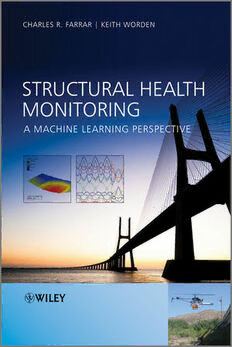Table Of ContentSTRUCTURAL HEALTH
MONITORING
STRUCTURAL HEALTH
MONITORING
A MACHINE LEARNING PERSPECTIVE
CharlesR.Farrar
LosAlamosNationalLaboratory,USA
KeithWorden
UniversityofSheffield,UK
A John Wiley & Sons, Ltd., Publication
Thiseditionfirstpublished2013
(cid:2)C 2013JohnWiley&Sons,Ltd
Registeredoffice
JohnWiley&SonsLtd,TheAtrium,SouthernGate,Chichester,WestSussex,PO198SQ,UnitedKingdom
Fordetailsofourglobaleditorialoffices,forcustomerservicesandforinformationabouthowtoapplyfor
permissiontoreusethecopyrightmaterialinthisbookpleaseseeourwebsiteatwww.wiley.com.
TherightoftheauthortobeidentifiedastheauthorofthisworkhasbeenassertedinaccordancewiththeCopyright,
DesignsandPatentsAct1988.
Allrightsreserved.Nopartofthispublicationmaybereproduced,storedinaretrievalsystem,ortransmitted,inany
formorbyanymeans,electronic,mechanical,photocopying,recordingorotherwise,exceptaspermittedbytheUK
Copyright,DesignsandPatentsAct1988,withoutthepriorpermissionofthepublisher.
Wileyalsopublishesitsbooksinavarietyofelectronicformats.Somecontentthatappearsinprintmaynotbe
availableinelectronicbooks.
Designationsusedbycompaniestodistinguishtheirproductsareoftenclaimedastrademarks.Allbrandnamesand
productnamesusedinthisbookaretradenames,servicemarks,trademarksorregisteredtrademarksoftheir
respectiveowners.Thepublisherisnotassociatedwithanyproductorvendormentionedinthisbook.This
publicationisdesignedtoprovideaccurateandauthoritativeinformationinregardtothesubjectmattercovered.Itis
soldontheunderstandingthatthepublisherisnotengagedinrenderingprofessionalservices.Ifprofessionaladvice
orotherexpertassistanceisrequired,theservicesofacompetentprofessionalshouldbesought.
LibraryofCongressCataloging-in-PublicationData
Farrar,C.R.(CharlesR.)
Structuralhealthmonitoring:amachinelearningperspective/CharlesR.Farrar,KeithWorden.
p.cm.
Includesbibliographicalreferencesandindex.
ISBN978-1-119-99433-6(cloth)
1.Structuralhealthmonitoring. I.Worden,K. II.Title.
TA656.6.F372012
624.1(cid:3)71–dc23
2012018036
AcataloguerecordforthisbookisavailablefromtheBritishLibraryandtheLibraryofCongress.
ISBN:978-1-119-99433-6
Typesetin9/11ptTimesbyAptaraInc.,NewDelhi,India
CRF:ToLorraine,Ican’timaginereceivingmoresupport
andencouragement!
KW:ToAnnaandGeorgewithlove.
Contents
Preface xvii
Acknowledgements xix
1 Introduction 1
1.1 HowEngineersandScientistsStudyDamage 2
1.2 MotivationforDevelopingSHMTechnology 3
1.3 DefinitionofDamage 4
1.4 AStatisticalPatternRecognitionParadigmforSHM 7
1.4.1 OperationalEvaluation 10
1.4.2 DataAcquisition 10
1.4.3 DataNormalisation 10
1.4.4 DataCleansing 11
1.4.5 DataCompression 11
1.4.6 DataFusion 11
1.4.7 FeatureExtraction 12
1.4.8 StatisticalModellingforFeatureDiscrimination 12
1.5 LocalversusGlobalDamageDetection 13
1.6 FundamentalAxiomsofStructuralHealthMonitoring 14
1.7 TheApproachTakeninThisBook 15
References 15
2 HistoricalOverview 17
2.1 RotatingMachineryApplications 17
2.1.1 OperationalEvaluationforRotatingMachinery 18
2.1.2 DataAcquisitionforRotatingMachinery 18
2.1.3 FeatureExtractionforRotatingMachinery 19
2.1.4 StatisticalModellingforDamageDetectioninRotatingMachinery 20
2.1.5 ConcludingCommentsaboutConditionMonitoringof
RotatingMachinery 21
2.2 OffshoreOilPlatforms 21
2.2.1 OperationalEvaluationforOffshorePlatforms 21
2.2.2 DataAcquisitionforOffshorePlatforms 24
2.2.3 FeatureExtractionforOffshorePlatforms 24
2.2.4 StatisticalModellingforOffshorePlatforms 25
2.2.5 LessonsLearnedfromOffshoreOilPlatformStructuralHealthMonitoring
Studies 25
viii Contents
2.3 AerospaceStructures 25
2.3.1 OperationalEvaluationforAerospaceStructures 28
2.3.2 DataAcquisitionforAerospaceStructures 29
2.3.3 FeatureExtractionandStatisticalModellingforAerospaceStructures 31
2.3.4 StatisticalModelsUsedforAerospaceSHMApplications 32
2.3.5 ConcludingCommentsaboutAerospaceSHMApplications 32
2.4 CivilEngineeringInfrastructure 32
2.4.1 OperationalEvaluationforBridgeStructures 34
2.4.2 DataAcquisitionforBridgeStructures 34
2.4.3 FeaturesBasedonModalProperties 35
2.4.4 StatisticalClassificationofFeaturesforCivilEngineeringInfrastructure 36
2.4.5 ApplicationstoBridgeStructures 36
2.5 Summary 37
References 38
3 OperationalEvaluation 45
3.1 EconomicandLife-SafetyJustificationsforStructuralHealthMonitoring 45
3.2 DefiningtheDamagetoBeDetected 46
3.3 TheOperationalandEnvironmentalConditions 47
3.4 DataAcquisitionLimitations 47
3.5 OperationalEvaluationExample:BridgeMonitoring 48
3.6 OperationalEvaluationExample:WindTurbines 51
3.7 ConcludingCommentonOperationalEvaluation 52
References 52
4 SensingandDataAcquisition 53
4.1 Introduction 53
4.2 SensingandDataAcquisitionStrategiesforSHM 53
4.2.1 StrategyI 54
4.2.2 StrategyII 54
4.3 ConceptualChallengesforSensingandDataAcquisitionSystems 55
4.4 WhatTypesofDataShouldBeAcquired? 56
4.4.1 DynamicInputandResponseQuantities 57
4.4.2 OtherDamage-SensitivePhysicalQuantities 59
4.4.3 EnvironmentalQuantities 59
4.4.4 OperationalQuantities 60
4.5 CurrentSHMSensingSystems 60
4.5.1 WiredSystems 60
4.5.2 WirelessSystems 61
4.6 SensorNetworkParadigms 63
4.6.1 SensorArraysDirectlyConnectedtoCentralProcessingHardware 64
4.6.2 DecentralisedProcessingwithHoppingConnection 65
4.6.3 DecentralisedProcessingwithHybridConnection 66
4.7 FutureSensingNetworkParadigms 67
4.8 DefiningtheSensorSystemProperties 68
4.8.1 RequiredSensitivityandRange 70
4.8.2 RequiredBandwidthandFrequencyResolution 71
4.8.3 SensorNumberandLocations 71
4.8.4 SensorCalibration,StabilityandReliability 72
4.9 DefinetheDataSamplingParameters 73
Contents ix
4.10 DefinetheDataAcquisitionSystem 74
4.11 ActiveversusPassiveSensing 75
4.12 MultiscaleSensing 75
4.13 PoweringtheSensingSystem 77
4.14 SignalConditioning 77
4.15 SensorandActuatorOptimisation 78
4.16 SensorFusion 79
4.17 SummaryofSensingandDataAcquisitionIssuesforStructuralHealthMonitoring 82
References 83
5 CaseStudies 87
5.1 TheI-40Bridge 87
5.1.1 PreliminaryTestingandDataAcquisition 89
5.1.2 UndamagedAmbientVibrationTests 90
5.1.3 ForcedVibrationTests 91
5.2 TheConcreteColumn 92
5.2.1 Quasi-StaticLoading 95
5.2.2 DynamicExcitation 95
5.2.3 DataAcquisition 95
5.3 The8-DOFSystem 98
5.3.1 PhysicalParameters 100
5.3.2 DataAcquisition 100
5.4 SimulatedBuildingStructure 100
5.4.1 ExperimentalProcedureandDataAcquisition 101
5.4.2 MeasuredData 102
5.5 TheAlamosaCanyonBridge 104
5.5.1 ExperimentalProceduresandDataAcquisition 104
5.5.2 EnvironmentalMeasurements 107
5.5.3 VibrationTestsPerformedtoStudyVariabilityofModalProperties 108
5.6 TheGnatAircraft 108
5.6.1 SimulatingDamagewithaModifiedInspectionPanel 109
5.6.2 SimulatingDamagebyPanelRemoval 112
References 116
6 IntroductiontoProbabilityandStatistics 119
6.1 Introduction 119
6.2 Probability:BasicDefinitions 120
6.3 RandomVariablesandDistributions 122
6.4 ExpectedValues 125
6.5 TheGaussianDistribution(andOthers) 130
6.6 MultivariateStatistics 132
6.7 TheMultivariateGaussianDistribution 133
6.8 ConditionalProbabilityandtheBayesTheorem 134
6.9 ConfidenceLimitsandCumulativeDistributionFunctions 137
6.10 OutlierAnalysis 140
6.10.1 OutliersinUnivariateData 140
6.10.2 OutliersinMultivariateData 141
6.10.3 CalculationofCriticalValuesofDiscordancyorThresholds 141
6.11 DensityEstimation 142
x Contents
6.12 ExtremeValueStatistics 148
6.12.1 Introduction 148
6.12.2 BasicTheory 148
6.12.3 DeterminationofLimitDistributions 151
6.13 DimensionReduction–PrincipalComponentAnalysis 155
6.13.1 SimpleProjection 156
6.13.2 PrincipalComponentAnalysis(PCA) 156
6.14 Conclusions 158
References 159
7 Damage-SensitiveFeatures 161
7.1 CommonWaveformsandSpectralFunctionsUsedintheFeatureExtractionProcess 163
7.1.1 WaveformComparisons 164
7.1.2 AutocorrelationandCross-CorrelationFunctions 165
7.1.3 ThePowerSpectralandCross-SpectralDensityFunctions 166
7.1.4 TheImpulseResponseFunctionandtheFrequencyResponseFunction 168
7.1.5 TheCoherenceFunction 169
7.1.6 SomeRemarksRegardingWaveformsandSpectra 170
7.2 BasicSignalStatistics 171
7.3 TransientSignals:TemporalMoments 178
7.4 TransientSignals:DecayMeasures 181
7.5 AcousticEmissionFeatures 183
7.6 FeaturesUsedwithGuided-WaveApproachestoSHM 185
7.6.1 Preprocessing 186
7.6.2 BaselineComparisons 186
7.6.3 DamageLocalisation 188
7.7 FeaturesUsedwithImpedanceMeasurements 188
7.8 BasicModalProperties 191
7.8.1 ResonanceFrequencies 192
7.8.2 InverseversusForwardModellingApproachestoFeatureExtraction 194
7.8.3 ResonanceFrequencies:TheForwardApproach 195
7.8.4 ResonanceFrequencies:SensitivityIssues 195
7.8.5 ModeShapes 197
7.8.6 Load-DependentRitzVectors 203
7.9 FeaturesDerivedfromBasicModalProperties 206
7.9.1 ModeShapeCurvature 207
7.9.2 ModalStrainEnergy 210
7.9.3 ModalFlexibility 215
7.10 ModelUpdatingApproaches 218
7.10.1 ObjectiveFunctionsandConstraints 220
7.10.2 DirectSolutionfortheModalForceError 221
7.10.3 OptimalMatrixUpdateMethods 222
7.10.4 Sensitivity-BasedUpdateMethods 226
7.10.5 EigenstructureAssignmentMethod 230
7.10.6 HybridMatrixUpdateMethods 231
7.10.7 ConcludingCommentonModelUpdatingApproaches 231
7.11 TimeSeriesModels 232
7.12 FeatureSelection 234
7.12.1 SensitivityAnalysis 234
7.12.2 InformationContent 238
Contents xi
7.12.3 AssessmentofRobustness 239
7.12.4 OptimisationProcedures 239
7.13 Metrics 239
7.14 ConcludingComments 240
References 240
8 FeaturesBasedonDeviationsfromLinearResponse 245
8.1 TypesofDamagethatCanProduceaNonlinearSystemResponse 245
8.2 MotivationforExploringNonlinearSystemIdentificationMethodsforSHM 248
8.2.1 CoherenceFunction 250
8.2.2 LinearityandReciprocityChecks 251
8.2.3 HarmonicDistortion 256
8.2.4 FrequencyResponseFunctionDistortions 261
8.2.5 ProbabilityDensityFunction 264
8.2.6 CorrelationTests 266
8.2.7 TheHolderExponent 266
8.2.8 LinearTimeSeriesPredictionErrors 271
8.2.9 NonlinearTimeSeriesModels 273
8.2.10 HilbertTransform 277
8.2.11 NonlinearAcousticsMethods 279
8.3 ApplicationsofNonlinearDynamicalSystemsTheory 280
8.3.1 ModellingaCrackedBeamasaBilinearSystem 281
8.3.2 ChaoticInterrogationofaDamagedBeam 282
8.3.3 LocalAttractorVariance 284
8.3.4 DetectionofDamageUsingtheLocalAttractorVariance 286
8.4 NonlinearSystemIdentificationApproaches 288
8.4.1 RestoringForceSurfaceModel 288
8.5 ConcludingCommentsRegardingFeatureExtractionBasedonNonlinearSystem
Response 291
References 292
9 MachineLearningandStatisticalPatternRecognition 295
9.1 Introduction 295
9.2 IntelligentDamageDetection 295
9.3 DataProcessingandFusionforDamageIdentification 298
9.4 StatisticalPatternRecognition:HypothesisTesting 300
9.5 StatisticalPatternRecognition:GeneralFrameworks 303
9.6 DiscriminantFunctionsandDecisionBoundaries 306
9.7 DecisionTrees 308
9.8 Training–MaximumLikelihood 309
9.9 NearestNeighbourClassification 312
9.10 CaseStudy:AnAcousticEmissionExperiment 312
9.10.1 AnalysisandClassificationoftheAEData 314
9.11 Summary 320
References 320
10 UnsupervisedLearning–NoveltyDetection 321
10.1 Introduction 321
10.2 AGaussian-DistributedNormalCondition–OutlierAnalysis 322
10.3 ANon-GaussianNormalCondition–ANeuralNetworkApproach 325
xii Contents
10.4 NonparametricDensityEstimation–ACaseStudy 329
10.4.1 TheExperimentalStructureandDataCapture 331
10.4.2 PreprocessingofDataandFeatures 332
10.4.3 NoveltyDetection 333
10.5 StatisticalProcessControl 338
10.5.1 FeatureExtractionBasedonAutoregressiveModelling 339
10.5.2 TheX-BarControlChart:AnExperimentalCaseStudy 340
10.6 OtherControlChartsandMultivariateSPC 343
10.6.1 TheSControlChart 344
10.6.2 TheCUSUMChart 344
10.6.3 TheEWMAChart 345
10.6.4 TheHotellingorShewhartT2Chart 346
10.6.5 TheMultivariateCUSUMChart 347
10.6.6 TheMultivariateEWMAChart 347
10.7 ThresholdsforNoveltyDetection 348
10.7.1 ExtremeValueStatistics 348
10.7.2 TypeIandTypeIIErrors:TheROCCurve 354
10.8 Summary 359
References 359
11 SupervisedLearning–ClassificationandRegression 361
11.1 Introduction 361
11.2 ArtificialNeuralNetworks 361
11.2.1 BiologicalMotivation 361
11.2.2 TheParallelProcessingParadigm 364
11.2.3 TheArtificialNeuron 365
11.2.4 ThePerceptron 366
11.2.5 TheMultilayerPerceptron 367
11.3 ANeuralNetworkCaseStudy:AClassificationProblem 372
11.4 OtherNeuralNetworkStructures 374
11.4.1 FeedforwardNetworks 374
11.4.2 RecurrentNetworks 375
11.4.3 CellularNetworks 375
11.5 StatisticalLearningTheoryandKernelMethods 375
11.5.1 StructuralRiskMinimisation 375
11.5.2 SupportVectorMachines 377
11.5.3 Kernels 381
11.6 CaseStudyII:SupportVectorClassification 382
11.7 SupportVectorRegression 384
11.8 CaseStudyIII:SupportVectorRegression 386
11.9 FeatureSelectionforClassificationUsingGeneticAlgorithms 389
11.9.1 FeatureSelectionUsingEngineeringJudgement 390
11.9.2 GeneticFeatureSelection 390
11.9.3 IssuesofNetworkGeneralisation 395
11.9.4 DiscussionandConclusions 397
11.10 DiscussionandConclusions 398
References 400
12 DataNormalisation 403
12.1 Introduction 403
12.2 AnExampleWhereDataNormalisationWasNeglected 405

